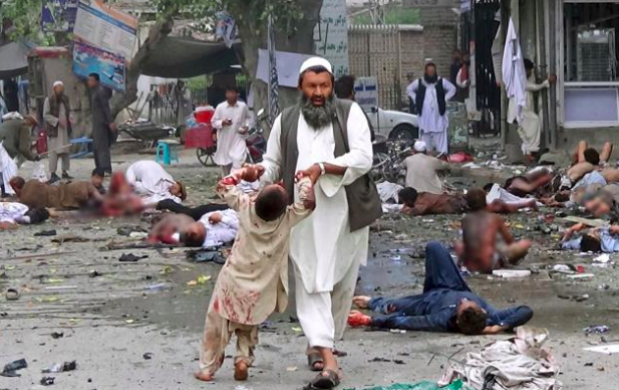Afghanistan Set To Top Its Own Record Of Civilian Deaths In 2015

NEW DELHI: As the Afghan government push for peace talks with the Taliban, trends regarding violence in Afghanistan take a turn for the worse. According to new figures released by the UN, the war in Afghanistan is killing or wounding increasing numbers of civilians, with women and children showing the sharpest rise in casualties. Figures for the first six months of 2015 put the year on the path to become the worst year yet in Afghanistan in terms of casualties.
(Source: UNAMA)
“Afghan civilians have suffered far too long from this destructive conflict. The devastating consequences of this violence against civilians as documented in this report should serve to strengthen the broad conviction that peace is urgently needed,” said Nicholas Haysom, head of the United Nations Assistance Mission to Afghanistan.
“Until peace is achieved, all parties to the conflict must fulfil their obligations under international humanitarian law to minimize the impact of the conflict on civilians and match their public statements on the protection of civilians with concrete actions,” said Haysom, who is also the UN Secretary-General's Special Representative for Afghanistan.
The first six months of 2015 have seen a 13 percent rise in child casualties when compared with the same period last year. The number of women killed and injured has increased by a sharp 23 percent. Total casualties have gone up too, but only by 1 percent when compared to record levels in 2014, with 1591 civilians killed and 3329 injured.
The figures reveal a worrying development regarding the war’s changing dynamic, i.e, the increasingly detrimental impact of the war on women and children. As overall casualties rise but only marginally, the brunt of the war has fallen on Afghanistan’s women and children -- evinced by the sharp rise in casualties among both groups.
This means that the war and its effects are moving closer to homes. Warring groups are increasingly turning to residential areas, where women and children are at risk of harm from indiscriminate weapons such as mortars, rockets and grenades.
“The rise in the numbers of women and children killed and maimed from conflict-related violence is particularly disturbing,” said Danielle Bell, UNAMA Director of Human Rights. “This year, UNAMA recorded the highest number of children and women casualties compared to the same period in previous years. All parties to the conflict must undertake stronger measures to protect civilians from harm. When the conflict kills or maims a mother, child, sister or brother, the repercussions for families and communities are devastating and long-lasting.”
In another worrying development, government forces -- as opposed to insurgent groups -- are the cause of a majority of these type of casualties, causing 59 percent of the deaths relating to the weapons listed above.
(Source: UNAMA)
For instance, on 5 June 2015, mortars used by Afghan national army soldiers killed eight children when they accidently struck a wedding party on the outskirts of Ghazni. The security forces responded with contradictory statements -- itself a worrying sign regarding the lack of transparency and accountability that is coming to characterize violence in Afghanistan.
Although insurgent groups remain the factor behind a majority of civilian casualties, the number of civilian casualties caused by government forces has seen a sharp rise. In the first six months of 2015, government forces killed or injured almost 300 more civilians as compared to the first half of 2014 -- representing a 60 percent increase. Government forces have in total been responsible for 16 percent of civilian casualties.
(Source: UNAMA)
“This report lays bare the heart-rending, prolonged suffering of civilians in Afghanistan, who continue to bear the brunt of the armed conflict and live in insecurity and uncertainty over whether a trip to a bank, a tailoring class, to a court room or a wedding party, may be their last,” said UN High Commissioner for Human Rights Zeid Ra’ad Al Hussein. “Impunity for serious violations of international human rights and humanitarian law has been reigning for too long in Afghanistan, and fuelling the cycle of violence. There need to be urgent, concrete steps towards accountability, to break this venomous cycle.”
Link to the full report: http://unama.unmissions.org/Portals/UNAMA/human



